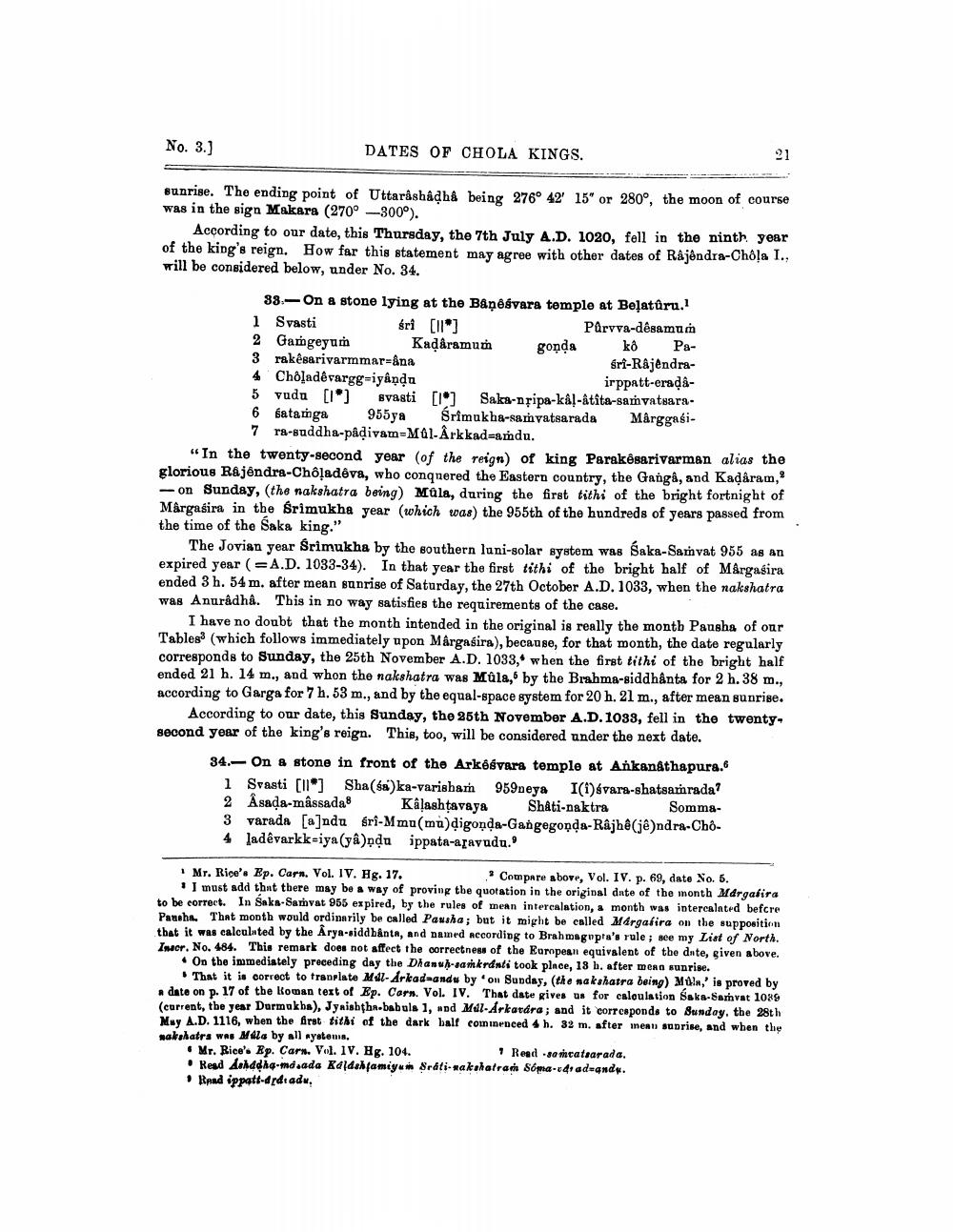________________
No. 3.)
DATES OF CHOLA KINGS.
21
sunrise. The ending point of Uttaråshådhå being 276° 42' 15" or 280°, the moon of course was in the sign Makara (270o ---300°).
According to our date, this Thursday, the 7th July A.D. 1020, fell in the ninth year of the king's reign. How far this statement may agree with other dates of Rajendra-Chôļa I., will be considered below, under No. 34.
88.- On & stone lying at the Baņēsvara temple at Beļatūru. 1 Svasti sri [11]
Parvva-desamun 2 Gamgeyum Kadâramum gonda kô Pa3 rakesarivarmmar=ana
sri-Rajendra4 Choladêvargg-iyându
irppatt-erada5 vudu [1] Svasti [1] Saka-n ripa-kal-Atta-samvatsara6 latamga 955ya Srimukha-samvatsarada Mârggasi
7 ra-buddha-padivam=Můl- Årkkad=amdu. "In the twenty-second year of the reign) of king Parakesarivarman alias the glorious Rajendra-Chladeva, who conquered the Eastern country, the Ganga, and Kaçáram,
-on Sunday, (the nakshatra being) Müla, during the first tithi of the bright fortnight of Margasira in the Srimukha year (which was) the 955th of the hundreds of years passed from the time of the Saka king."
The Jovian year Srimukha by the southern luni-solar system was Saka-Samvat 955 as an expired year (=A.D. 1033-34). In that year the first tithi of the bright half of Margasira ended 3 h. 54 m. after mean sunrise of Saturday, the 27th October A.D. 1033, when the nakshatra was Anuradha. This in no way satisfies the requirements of the case.
I have no doubt that the month intended in the original is really the month Pausha of our Tables (which follows immediately upon Mârgasira), because, for that month, the date regularly corresponds to Sunday, the 25th November A.D. 1033, when the first tithi of the bright half ended 21 h. 14 m., and whon the nakshatra was Mûla, by the Brahma-siddhanta for 2 h.38 m., according to Garga for 7 h. 53 m., and by the equal-space system for 20 h. 21 m., after mean sunrise.
According to our date, this Sunday, the 25th November A.D. 1033, fell in the twenty, second year of the king's reign. This, too, will be considered under the next date.
34.- On & stone in front of the Arkógvara temple at Ankanathapura.
1 Svasti (11) Sha(s)ka-varisham 959peya (1)svars-shatsamrada? 2 Asada-mâssada Kalashtavaya Shâti-naktra 3 varada [a]ndu fri-Mmumu digonda-Gangegonda-Rajhê(je)ndra-Cho4 ladêvarkk-iya (ya) da ippata-apavudu.
Mr. Rice's Bp. Carn. Vol. IV. Hg. 17.
. Compare above, Vol. IV. p. 69, date No. 5. " I must add that there may be a way of proving the quotation in the original date of the month Margafira to be correct. In Saka-Samvat 956 expired, by the rules of mean intercalation, a month was intercalated befcre Panohe. That month would ordinarily be called Pausha; but it might be called Margalira on the supposition that it was calculated by the Arya-siddbånts, and named according to Brahmsgupta's rule; see my List of North. Inscr. No. 484. This remark does not affect the correctness of the European equivalent of the date, given above. • On the immediately preceding day the Dhanuh-sankranti took plnce, 18 h. after maa sunrise.
That it is correct to tranplate Mil-Arkadaandu by on Sunday date on p. 17 of the Roman text of Ep. Corn. Vol. IV. That date gives us for calculation Saka-Samvat 1039 (current, the year Durmukhs), Jyaishthn-babuls 1, and MdlArkatára; and it corresponds to Sunday, the 28th May A.D. 1116, when the first tithi of the dark ball cominenced 4 h. 32 m. after mean suprise, and when the nakshatra was Mala by all aystems,
• Mr. Rice'. Ep. Cars. Vol. IV. Hg. 104. • Read Anddha-md.ada Kaldalfamigui Sráti-nakshatran Soma-edıad-andy. • Raad ippatt-drdtadu,




